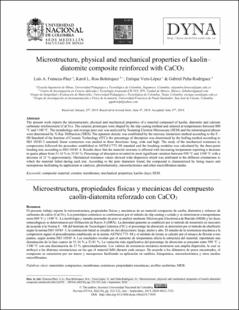Microstructure, physical and mechanical properties of kaolin - diatomite composite reinforced with CaCO3
Artículo de revista
2019-07-01
DYNA
The present work reports the microstructure, physical and mechanical properties of a material composed of kaolin, diatomite and calcium carbonate reinforcement (CaCO3). The ceramic prototypes were shaped by the slip casting method and sintered at temperatures between 800 °C and 1100 °C. The morphology and average pore size was analyzed by Scanning Electron Microscopy (SEM) and the mineralogical phases were determined by X-Ray Diffraction (XRD). The apparent density was established by the mercury immersion method according to the E – 8B Standard of the Institute of Ceramic Technology (ITC); the percentage of absorption was determined by the boiling method according to ISO 10545-3 standard; linear contraction was studied in three directions: long, wide and high. The study of the mechanical resistance to compression followed the procedure established at ASTM C773–88 standard and the breaking modulus was calculated by the three-point bending test, according to ISO 10545–4. Results show that the material structure is affected with increasing temperature reporting a decrease in quartz phase from 51.16 % to 33.81 %. Percentage of absorption revealed its most significant variation between 950 °C and 1100 °C with a decrease of 21 % approximately. Mechanical resistance values showed wide dispersion which was attributed to the different orientations in which the material failed during each test. According to the pore diameters found, the compound is characterized by being macro and mesoporous facilitating its application in catalysis, photochemistry, microelectronics and other microfiltration media El presente trabajo reporta la microestructura, propiedades físicas y mecánicas de un material compuesto de caolín, diatomita y refuerzo de carbonato de calcio (CaCO3). Los prototipos cerámicos se conformaron por el método de slip casting o colado y se sinterizaron a temperaturas entre 800 °C y 1100 °C. La morfología y tamaño promedio de poro se analizó mediante Microscopía Electrónica de Barrido (MEB) y las fases mineralógicas se determinaron por Difracción de Rayos X (DRX). La densidad aparente se estableció por el método de inmersión en mercurio de acuerdo a la Norma E – 8B del Instituto de Tecnología Cerámica (ITC); el porcentaje de absorción se determinó por el método de ebullición según la norma ISO 10545–3; la contracción lineal se estudió en tres direcciones: largo, ancho y alto. El estudio de la resistencia mecánica a la compresión siguió el procedimiento establecido en la norma ASTM C773–88 y el módulo de rotura se calculó por el ensayo de flexión a tres puntos, según norma ISO 10545–4. Los resultados revelan que el aumento de temperatura afecta la estructura del material, reportando una disminución de la fase cuarzo de 51.16 % a 33.81 %. La variación más significativa del porcentaje de absorción se presentó entre 950 °C y 1100 °C con una disminución de 21 % aproximadamente. Los valores de resistencia mecánica mostraron una amplia dispersión, la cual se atribuyó a las distintas orientaciones en las que el material falló durante cada ensayo. De acuerdo a los diámetros de poros encontrados, el compuesto se caracteriza por ser macro y mesoporoso facilitando su aplicación en catálisis, fotoquímica, microelectrónica y otros medios microfiltrantes.
Descripción:
Microstructure, physical and mechanical properties of kaolin - diatomite composite reinforced with CaCO3.pdf
Título: Microstructure, physical and mechanical properties of kaolin - diatomite composite reinforced with CaCO3.pdf
Tamaño: 2.826Mb
 PDF
PDF
 LEER EN FLIP
LEER EN FLIP
Título: Microstructure, physical and mechanical properties of kaolin - diatomite composite reinforced with CaCO3.pdf
Tamaño: 2.826Mb
 PDF
PDF
 LEER EN FLIP
LEER EN FLIP
















